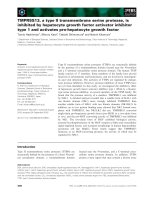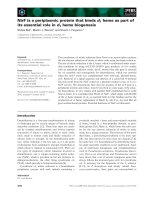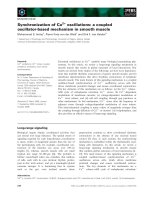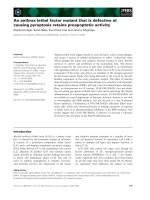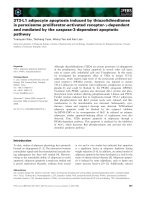Tài liệu Báo cáo khoa học: It is all about resolution Meeting report based upon presentations at the 10th International Global BioMillennium 2006 symposium on molecular cell biology (Tbilisi, Georgia) docx
Bạn đang xem bản rút gọn của tài liệu. Xem và tải ngay bản đầy đủ của tài liệu tại đây (72.46 KB, 4 trang )
REVIEW ARTICLE
It is all about resolution
Meeting report based upon presentations at the 10th International
Global BioMillennium 2006 symposium on molecular cell biology
(Tbilisi, Georgia)
Hermona Soreq
1
and Alik Honigman
2
1 Department of Biological Chemistry, The Hebrew University of Jerusalem, Israel
2 Department of Virology, The Hebrew University of Jerusalem, Israel
Introduction
Improved resolution in time and space is the hallmark
of studies in diverse subfields of the life sciences,
including epigenetics, structural biology, and electron
tomography. Combined with dynamic imaging of
immune cells and with data management of cDNA
microarrays, such studies yield reliable synchronization
of cell cycle events, with one goal being the develop-
ment of specific microRNA and protein signatures of
particular tumor cell types, and another being to fol-
low the dynamics of neurite growth in the live brains
of mice.
Meeting report
From birth to death of gene products
Until recently, epigenetic mechanisms have been
equated with the inheritance of chromosomal hetero-
chromatin. Evidence that transcriptionally active
states of chromatin can also be epigenetically main-
tained was presented by A. Francis Stewart
(Dresden). Silencing methylations are epigenetically
maintained via methyltransferases that associate with
proteins that recognize the methylated epitope and
propagate the silent state. Together, these observations
Keywords
alternative splicing; cellular imaging;
chromatin; ribosomes; siRNA; ubiquitin
Correspondence
H. Soreq, Department of Biological
Chemistry, The Hebrew University of
Jerusalem, Jerusalem 91904, Israel
Fax: +972 2 652 0258
Tel: +972 2 658 5109
E-mail:
(Received 23 August 2006, revised 20
November 2006, accepted 11 December
2006)
doi:10.1111/j.1742-4658.2007.05640.x
The 2006 Global BioMillennium Conference took place in Tbilisi, Georgia,
on 13–17 July 2006. The Conference was focused on key aspects of gene
expression processes. Characteristic of state-of-the-art research in the life
sciences, the invited lectures spanned approaches in cell biology, gene
expression, and protein function. A particular aspect that is special to the
BioMillenium series of conferences (this has been the 10th in this series) is
the emphasis on new and emerging technologies; the various experts in the
subfields that were covered presented what, in their view, should be critical
to enabling future progress.
Abbreviations
DAP, death-associated protein; hnRNP, heterogeneous nuclear ribonucleoprotein; miRNA, micro RNA; MMP, matrix metalloprotease.
924 FEBS Journal 274 (2007) 924–927 ª 2007 The Authors Journal compilation ª 2007 FEBS
support a polarization model of chromatin that rein-
forces stability.
Three post-transcriptional regulation mechanisms
were presented. Alternative splicing facilitates large pro-
teomic complexity with a limited number of genes, as
was discussed by Javier F. Caceres (Edinburgh, UK).
The trans-acting factors involved include both serine-
arginine (SR) and heterogeneous nuclear ribonucleo-
protein (hnRNP) A ⁄ B proteins, with antagonisti c
activities influencing different modes of alternative spli-
cing in vivo, affecting tissue-specific or developmental
regulation of gene expression. Certain SR and hnRNP
proteins shuttle continuously between the nucleus and
the cytoplasm. Interestingly, hnRNP A1 binds to and is
necessary for the processing of a cluster of intronic
microRNAs suggested to act as a human oncogene.
Nonsense-mediated mRNA decay selectively degrades
mRNAs harboring premature termination codons. In
humans, nonsense-mediated mRNA is linked to
splicing, but in Drosophila and also in Caenorhabditis
elegans, it occurs independently of introns. A polarity
effect reduces nonsense-mediated mRNA sensitivity to a
region close to the 3¢-end of the mRNA.
As a next step in the study of the regulation of
gene expression, Ada Yonath (Rehovot, Israel)
linked ribosomal architecture with antibiotic action.
In all known ribosome structures, an internal symmet-
rical region connects all functional features. The sym-
metry relates the RNA backbone to nucleotide
orientation, but shows no sequence homology. This
demonstrates the superiority of function over
sequence conservation, suggesting that ribosomes
evolved by gene fusion. Antibiotics complexed with
ribosomes from an archaeon that shares properties
with eukaryotes illuminated the structural elements
required for therapeutic effectiveness. Structural bio-
logy can hence become a key tool for developing
novel antibiotics.
Post-translational regulation was discussed by Aaron
Ciechanover (Haifa, Israel), who argued that the
ubiquitin proteolytic system covers the pathway for
elucidating the basic mechanisms that are pivotal for
drug targeting. Degradation of cellular proteins plays
major roles in a multitude of basic pathways during
cell life and death, in both health and disease. The
ubiquitin–proteasome pathway involves conjugation of
multiple ubiquitin moieties to the substrate and subse-
quent degradation of the tagged protein, which
involves the downstream 26S proteasome complex and
unknown mechanisms. The common thread in all of
these topics is far greater complexity than was previ-
ously perceived, and the need for methods that achieve
the maximum resolution.
Imaging genomic and cellular properties
Different technologies dealing with real-time imaging
of molecular events, which has become a major tool in
biological research, were presented.
Hans J. Tanke (Leiden, the Netherlands) described
cellular imaging of telomere localization and dynamics
in normal cells and in cancer cells using a fluorescently
labeled peptide nucleic acid probe with a sequence
complementary to telomeric DNA. Engineering of
fusion proteins of telomere-binding proteins with yel-
low fluorescent protein and time-lapse imaging were
used to follow the dynamic behavior of telomeres,
which were shown to interact dynamically with nuclear
bodies.
Matthias Gunzer (Braunschweig, Germany) studies
cell motility and migration of immune cells, which
changes considerably when classical liquid cell culture
systems are exchanged for more physiologic environ-
ments. Mimicking the features of true extracellular
tissue can be achieved by embedding the cells in hydra-
ted gels of type 1 collagen, or in undisturbed tissues of
living animals.
Itamar Simon (Jerusalem, Isreal) described a gen-
ome-wide analysis of the human cell cycle in primary
cells. Combining microarray expression data with pre-
cise measurements of the culture synchrony at each
time point enables deconvolution of the temporal
expression signal, yielding coherent, single cell-based
expression patterns. Microarray and complementary
fluorescence-activated cell sorting experiments were
used to test a number of arrest methods for normal
fibroblast cells. Combination of the findings with exist-
ing cancer cell cycle data highlights three groups of
genes ) those that cycle in both cancer and normal
cells; those that cycle only in normal cells; and those
that cycle only in cancer cells ) providing new insights
into the transformation process.
Continuous exchange of macromolecules between
the nucleus and cytoplasm is mediated by nuclear pore
complexes, macromolecular assemblies that fuse the
inner and outer nuclear membrane and form aqueous
channels for translocation. Ohad Medalia (Beer-Sheva,
Israel) reported on structural analysis of the nuclear
pore complex by cryo-electron tomography, exploring
transport-active intact nuclei from the slime mold
Dictyostelium discoideum. Computerized three-dimen-
sional classification and averaging provided a refined
structure of the nuclear pore complex, enabling the
construction of the trajectories of import complexes
using gold-labeled substrates.
Nuclear export emerges as the major regulatory
mechanism of the nuclear accumulation of STAT2, as
H. Soreq and A. Honigman It is all about resolution
FEBS Journal 274 (2007) 924–927 ª 2007 The Authors Journal compilation ª 2007 FEBS 925
reported by Hansjo
¨
rg Hauser (Braunschweig, Ger-
many). In the absence of interferon, STAT2 perma-
nently and rapidly shuttles between the cytoplasm and
the nucleus. A region in the C-terminus of STAT2
controls its specific export in the absence of interferon.
STAT1 also shuttles in the absence of interferon, but
the exchange rate in unstimulated cells is more than 10
times lower. In this context Georgyi Los (Madison,
WI, USA) and Marjeta Urh (Madison, WI, USA)
described the use of a fusion between a modified halo-
genase and target proteins to explore protein functions
and dynamics in live cells.
Adi Kimchi (Rehovot, Israel) reported on mole-
cular networks involved in programmed cell death.
She identified gene products, named DAPs (death -
associated proteins), that differ substantially in their
biochemical properties and intracellular localization.
DAP-kinases (DAPk), Ca
2+
⁄ calmodulin-regulated
and Ser ⁄Thr kinases, activate signaling pathways that
lead to cell death through membrane blebbing and
autophagic cell death. Two closely related kinases,
ZIPk and DRP-1, mediate trans-phosphorylation and
subsequent functional activation of ZIPk. DAP5 is a
translation initiation factor that directs internal ribo-
some entry site (IRES)-dependent translation under
stress conditions when translation dependent on
5¢ methyl-protected guanosine, designated ‘cap’, is
compromised. RNA interference technology serves to
knock down various components of the network
singly or in combination, and validate these conclu-
sions. The linking theme in this session highlighted
the need to combine various methodologies in the
search for regulatory events.
Approaching tumorigenesis
The challenge of cross-platform analysis of cancer
microarray data was presented by Roland Eils (Heidel-
berg), who uses median rank scores and quantile dis-
cretization to derive numerically comparable measures
of gene expression from different platforms. Applied
to six publicly available cancer microarray gene expres-
sion datasets from three pairs of studies, this approach
was used for examining breast cancer, prostate cancer
and acute myeloid leukemia. Two leukemia microarray
datasets were further employed to identify important
genes with regard to the biology of leukemia. Import-
antly, these could be found in an integrated analysis
but were missed in the single-set analyses. Cross-
platform classification of multiple cancer microarray
datasets may yield discriminative gene expression sig-
natures generated by different laboratories and micro-
array technologies.
Reuven Agami (Amsterdam, the Netherlands) dem-
onstrated the identification of oncogenic microRNAs
using a functional genetic screen. The number of veri-
fied human micro (mi)RNAs is still expanding, but
only few have been functionally annotated. Agami and
colleagues developed a library of vectors expressing the
majority of cloned human miRNAs, and created
corresponding DNA ‘barcode’ arrays. miR-372 and
miR-373 were identified, each permitting proliferation
and tumorigenesis of primary human cells, neutralizing
p53-mediated CDK2 inhibition. High-throughput for-
mats of miRNA screens will be required to search for
other cancer-related functions of miRNAs.
The emerging approach of dynamic imaging of pro-
tease function in cancer cell invasion was covered by
Peter Friedl (Wu
¨
rzburg, Germany), who combined
confocal and multiphoton microscopic imaging of cell
dynamics. During invasive single-cell migration, the
cleavage of individual fiber belts occurs at regions of
focal pressure, such as fiber insertions at branching
pseudopods or nuclear compression zones. These open
small degradation tracks, and continuously expanding
tubes then become filled with cells and mobile cell
masses. Pericellular proteolysis is hence a prerequisite
for expansive tumor growth, collective invasion and
large-scale tissue reshaping. In contrast, single-cell dis-
semination associated with subtle extracellular matrix
remodelling is mechanistically independent of protease
function and may be rescued by nonproteolytic escape
strategies. In this session as well, the complexity of
processes and the need for high-resolution strategies
were evident.
Addressing the brain frontiers
Adi Mizrahi (Jerusalem, Israel) reported the use of
two-photon microscopy for studying how neuronal
dendrites form in adult-born neurons that continuously
develop into the olfactory bulb. Lentivirus green fluor-
escent protein-labeled neurons were used to directly
follow dendritic development in vivo. Within a single
day, neuronal morphology changed dramatically, with
both formation and retraction of whole dendritic trees.
After 10 days, most of the neurons were still migra-
ting. After 45 days, most granule neurons had comple-
ted migration and showed elaborate, complex dendritic
trees. The dynamics of neuronal development in the
intact mammalian brain are hence amenable to further
study.
Elias Michaelis (Lawrence, KS, USA) covered the
establishment of the Glud1 transgenic mouse, which
overexpresses the mitochondrial enzyme glutamate
dehydrogenase 1 (GLUD1), positioned at the second-
It is all about resolution H. Soreq and A. Honigman
926 FEBS Journal 274 (2007) 924–927 ª 2007 The Authors Journal compilation ª 2007 FEBS
to-last enzymatic step in the pathway for biosynthesis
of Glu as a transmitter. Transgenic mice suffer losses
in specific neuronal populations, e.g. pyramidal neu-
rons of the somatosensory cortex, the CA1 region of
the hippocampus, and motoneurons of the spinal cord,
and show extensive damage to dendrites and axons of
spinal cord motor neurons. Importantly, the GLUD1
hippocampus showed higher expression in transgenic
stress response genes, Ca
2+
-regulating genes, and
genes whose products control cell survival and neurite
growth. Neuronal signaling regulated by intracellular
Ca
2+
and oxidative stress is hence associated with
raft-like domains in membranes. Luciferase-based
reporter bioluminescence assays reported by Keith V.
Wood (Madison, WI, USA) offer new methods for
measuring such responses, which may become import-
ant targets for therapeutic intervention against neuro-
degeneration and age-dependent cognitive decline.
Anxiety disorders present a major mental health
problem. Hermona Soreq (Jerusalem, Israel) discussed
anxiety-induced changes in cholinergic neurotransmis-
sion that modulate motor control over movement,
working memory, and brain-to-body communication
through the neuron–immune system interface, modify-
ing blood cell composition and platelet production.
Importantly, the acetylcholinesterase ACHE gene
encodes not one protein, but a combinatorial series of
proteins with indistinguishable enzymatic activity but
with variant N-termini and C-termini, due to alternat-
ive promoter usage and 3¢-alternative splicing. These
show distinct nonhydrolytic properties, interact with
variant-specific protein partners, and induce inverse
signaling cascades. Specifically, causal involvement of
both butyrylcholinesterase and acetylcholinesterase in
the progression of Alzheimer’s and Parkinson’s dis-
eases anticipates future therapeutic needs for drugs
targeting specific cholinesterases or the corresponding
RNA transcripts.
Last, but not least, in this session was Leszek Kacz-
marek (Warsaw, Poland), who discussed extracellular
proteolysis in neuronal plasticity, learning and mem-
ory. C-Fos and its functional form, the AP-1 transcrip-
tion factor, emerged in his studies as the best correlate
of learning processes, especially of the behavioral
information. Matrix metalloproteinases (MMPs) are
pivotal for tissue remodeling in the rodent hippocam-
pus, where both matrix metalloproteinase protein-9
(MMP-9) protein and its transcript are associated with
a subset of dendritic spines bearing asymmetric, excita-
tory synapses. Furthermore, functional inactivation of
MMP-9 by means of either gene knockout, or specific
chemical inhibitors or TIMP-1, delivered by an adeno-
virus vector, affected neuronal plasticity and blocked
the late phase of long-term potentiation as well as hip-
pocampus-dependent learning. Thus, several different
proteins were discussed in this session as being relevant
for neuronal events characteristic of brain development
and aging; however, the gap between cellular and
molecular studies appeared to be larger in neuroscience
than in tumor-related projects.
Acknowledgements
We would like to thank the Promega Corporation of
Madison, WI, USA for supporting this meeting.
Supplementary material
The following supplementary material is available
online:
Doc. S1. Supplementary bibliography.
This material is available as part of the online article
from
Please note: Blackwell Publishing is not responsible
for the content or functionality of any supplementary
materials supplied by the authors. Any queries (other
than missing material) should be directed to the corres-
ponding author for the article.
H. Soreq and A. Honigman It is all about resolution
FEBS Journal 274 (2007) 924–927 ª 2007 The Authors Journal compilation ª 2007 FEBS 927



